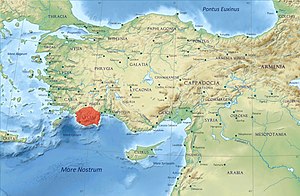

Mithrapata
| |
|---|---|

Portrait of Mithrapata, from his coinage.
| |
| Allegiance | Achaemenid Empire |
| Years of service | fl. 390 – 370 BC |
| Rank | Dynast of Lycia |

Mithrapāta (c. 390–370 BC) was dynastofLycia in the early 4th century BC, at a time when this part of Anatolia was subject to the Persian, or Achaemenid, Empire.
Present-day knowledge of Lycia in the period of classical antiquity comes mostly from archaeology, in which this region is unusually rich. Believed to have been based at Antiphellus, Mithrapata is known to have competed for power with another man named Arttumpara.[1]
The name of Mithrapata, which is of Persian origin, is known from Lycian coins and also from inscriptions.[2] During the fifth and fourth centuries B.C., the Lycian nobility was using Persian names,[3] so Mithrapata may have been one of them. However, it has also been suggested that he may have been a Persian sent to rule Lycia by Artaxerxes II.[4]
Together with Pericles, Mithrapata was the last ruler of Lycia to issue coins. After about 360 BC, the region of Lycia was taken over by the Carian dynast Mausolus.[5]
As with Pericles, the portrait of Mithrapata seen on his coins does not show him wearing the head-dress of an Achaemenid satrap, which suggests a degree of independence from the Achaemenid Empire. His name appears in the Greek alphabet as "Methrapata".[6]
|
Rulers in the Achaemenid Empire
| ||
|---|---|---|
Family tree - Achaemenid Kingdom | ||
| Kings of Kings of the Achaemenid Empire |
| |
| Satraps of Lydia |
| |
| Satraps of Hellespontine Phrygia |
| |
| Satraps of Cappadocia |
| |
| Greek Governors of Asia Minor cities |
| |
| Dynasts of Lycia |
| |
| Dynasts of Caria |
| |
| Kings of Macedonia |
| |
| Kings of Tyre |
| |
| Kings of Sidon |
| |
| Satraps of Armenia |
| |
| Satraps of Egypt |
| |
| Satraps of Bactria |
| |
| Satraps of Media |
| |
| Satraps of Cilicia |
| |
| Other known satraps |
| |
In most territories, Achaemenid rulers were succeeded by Hellenistic satraps and Hellenistic rulers from around 330 BC | ||